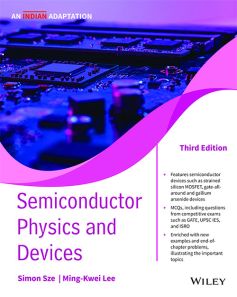Semiconductor Physics And Devices, 3ed, An Indian Adaptation
ISBN: 9789354243226
608 pages
For more information write to us at: acadmktg@wiley.com

Description
Semiconductor Physics and Devices is a comprehensive textbook written for the undergraduate students of electronics engineering, electrical engineering, applied science, and materials science. The book first provides a summary of the basic properties of semiconductor materials, covering energy band, carrier concentration, and transport properties, emphasizing silicon and gallium arsenide. It then examines p−n diodes, bipolar transistors, MOSFETs, and other field-effect transistors such as MESFETs, MODEFTs, negative-resistance and power devices, and photonic devices and sensors, including light-emitting diodes, photodetectors, and solar cells.
Chapter 0 Introduction
0.1 Semiconductor Devices
0.2 Semiconductor Technology
0.3 Summary
Chapter 1 Basic Physics of Semiconductors
1.1 Semiconductor Materials
1.2 Basic Crystal Structures
1.3 Valence Bonds
1.4 Quantum Physics of Semiconductors
1.5 Band Structure Calculations
1.6 Bandgaps in Semiconductors
1.7 Intrinsic Carrier Concentration
1.8 Donors and Acceptors
1.9 Density of States
1.10 Summary
Chapter 2 Carrier Transport Phenomena
2.1 Carrier Drift
2.2 Carrier Diffusion
2.3 Generation and Recombination Processes
2.4 Continuity Equation
2.5 Thermionic Emission Process
2.6 Tunneling Process
2.7 Space-Charge Effect
2.8 High-Field Effects
2.9 Summary
Chapter 3 p–n Junction
3.1 Thermal Equilibrium Condition
3.2 Depletion Region
3.3 Depletion Capacitance
3.4 Current-Voltage Characteristics
3.5 Charge Storage and Transient Behavior
3.6 Junction Breakdown
3.7 Heterojunction
3.8 Summary
Chapter 4 Bipolar Transistors
4.1 Transistor Action
4.2 Static Characteristics of Bipolar Transistors
4.3 Frequency Response and Switching of Bipolar Transistors
4.4 Nonideal Effects
4.5 AC Equivalent Circuits
4.6 Heterojunction Bipolar Transistors
4.7 Summary
Chapter 5 Field Effect Transistors
5.1 Ideal MOS Capacitor
5.2 SiO2-Si MOS Capacitor
5.3 Carrier Transport in MOS Capacitors
5.4 Charge-Coupled Devices (CCD)
5.5 JFET Fundamentals
5.6 JFET Device Characteristics
5.7 MOSFET Fundamentals
5.8 Summary
Chapter 6 Advanced MOSFET Devices
6.1 MOSFET Scaling
6.2 CMOS and BiCMOS
6.3 MOSFET on Insulator
6.4 Gate-All-Around (GAA) Device
6.5 MOS Memory Structures
6.6 Summary
Chapter 7 MESFET and Related Devices
7.1 Metal-Semiconductor Contacts
7.2 MESFET
7.3 MODFET
7.4 Summary
Chapter 8 Microwave Diodes; Power, Quantum-Effect, and Hot-Electron Devices
8.1 Microwave Frequency Bands
8.2 Tunnel Diode
8.3 Gunn Diode
8.4 IMPATT Diode
8.5 Zener Diode
8.6 Varactor Diode
8.7 Gallium Arsenide Devices
8.8 Thyristors and Related Power Devices
8.9 Power MOSFET
8.10 Power BJT
8.11 Transferred-Electron Devices
8.12 Quantum-Effect Devices
8.13 Hot-Electron Devices
8.14 Summary
Chapter 9 Optical Devices: Light-Emitting Diodes and Lasers
9.1 Radiative Transitions and Optical Absorption
9.2 Light-Emitting Diodes
9.3 Various Light-Emitting Diodes
9.4 Semiconductor Lasers
9.5 Summary
Chapter 10 Optical Devices: Photodetectors and Solar Cells
10.1 Photodetectors
10.2 Solar Cells
10.3 Silicon and Compound-Semiconductor Solar Cells
10.4 Third-Generation Solar Cells
10.5 Optical Concentration
10.6 Summary
Chapter 11 Semiconductor Process Technology
11.1 Oxidation
11.2 Diffusion
11.3 Ion Implantation
11.4 Silicon Crystal Growth from the Melt
11.5 GaAs Crystal-Growth Techniques
11.6 Molecular Beam Epitaxy Techniques
11.7 Chemical Vapor Deposition of Dielectrics
11.8 Sputtering
11.9 Lithography and Etching
11.10 Next-Generation Lithographic Methods
11.11 Wet Chemical Etching
11.12 Dry Etching
11.13 Twin-Tub CMOS Process
11.14 Summary
Chapter 12 Integrated Devices
12.1 Passive Components
12.2 Bipolar Technology
12.3 MOSFET Technology
12.4 MESFET Technology
12.5 Challenges for Nanoelectronics
12.6 Summary
Appendix A Glossary
Appendix B List of Symbols
Appendix C International System of Units (Sl Units)
Appendix D Unit Prefixes*
Appendix E Greek Alphabet
Appendix F Physical Constants
Appendix G Properties of Important Element and Binary Compound Semiconductors at 300 K
Appendix H Properties of Si and GaAs at 300 K
Appendix I Derivation of the Density of States in a Semiconductor
Appendix J Derivation of Recombination Rate for Indirect Recombination
Appendix K Calculation of the Transmission Coefficient for a Symmetric Resonant-Tunneling Diode
Appendix L Basic Kinetic Theory of Gases
Supplements

